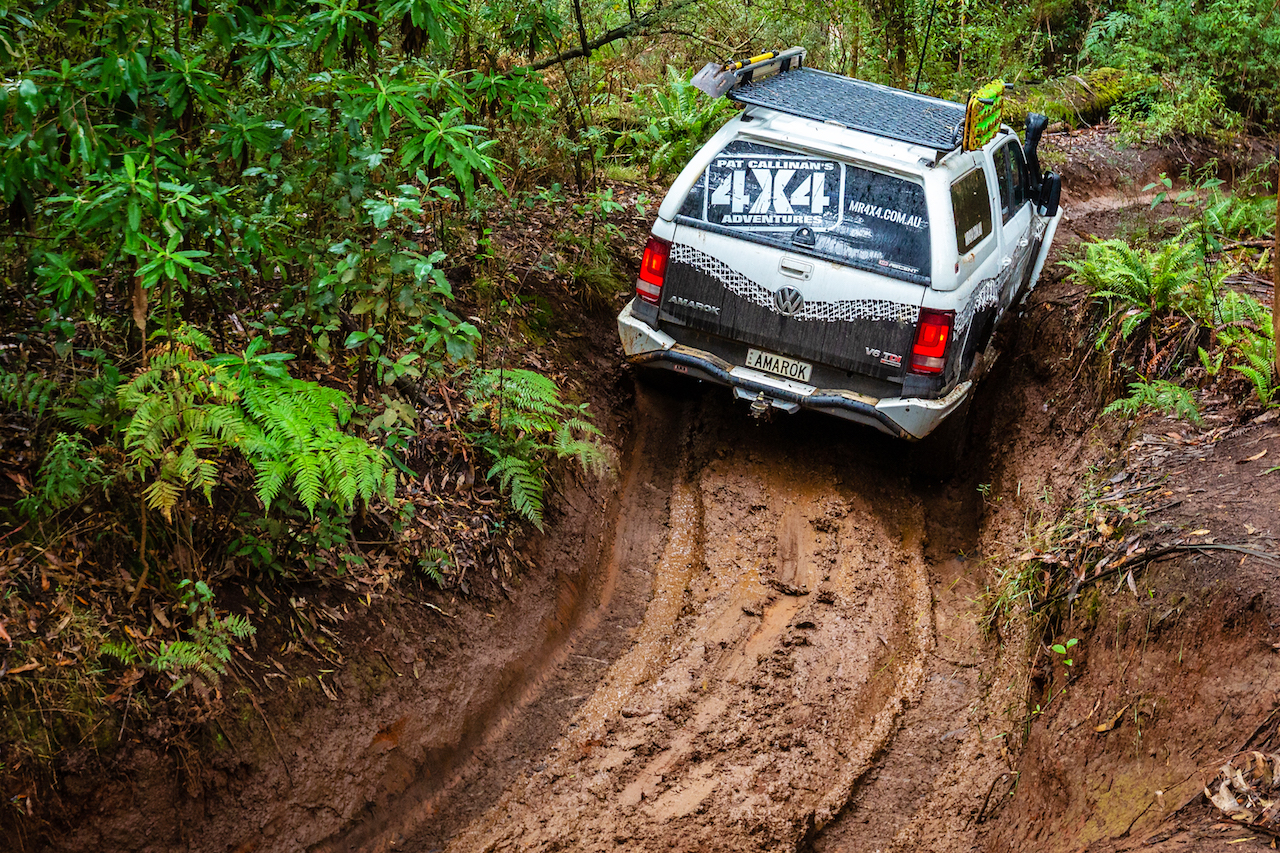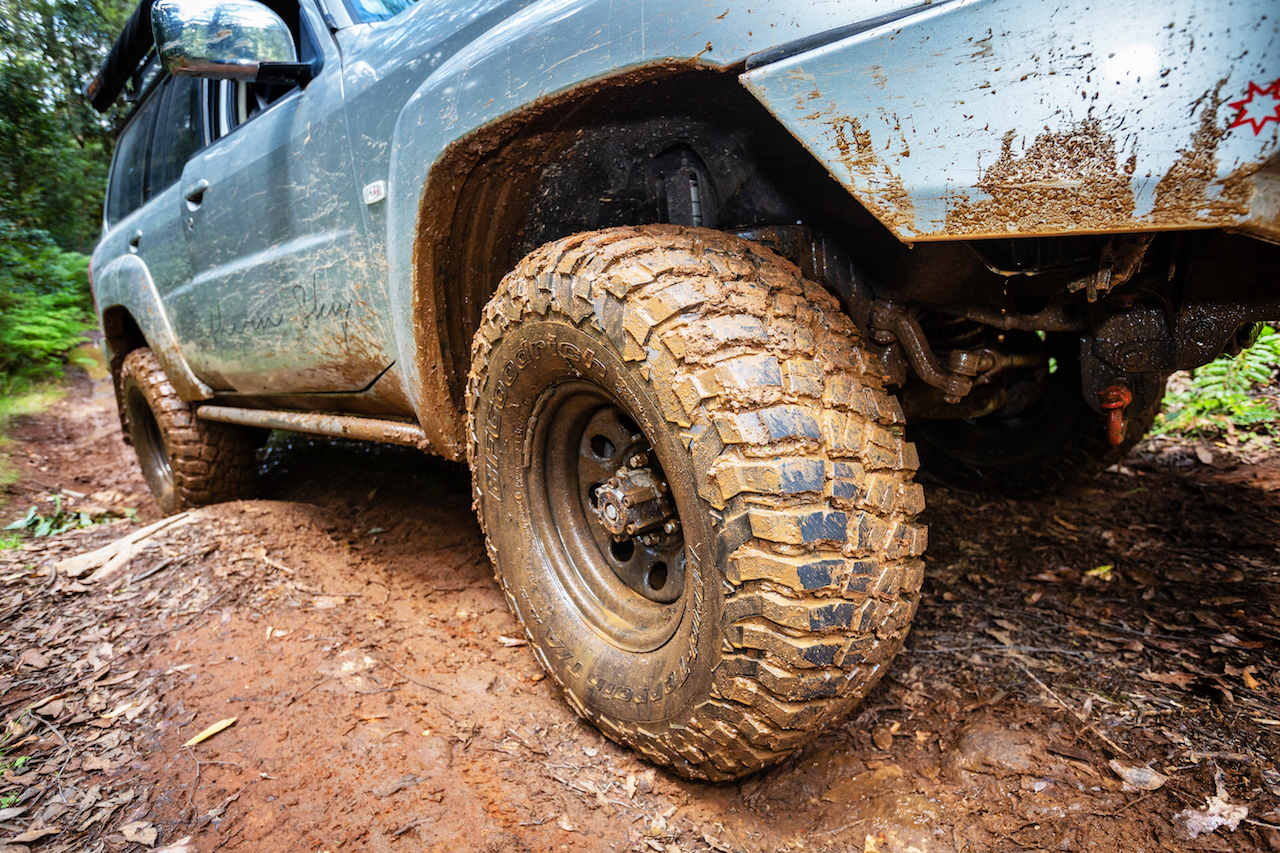Driving in mud is one of those four-wheel driving experiences that some people love and some loathe. Here’s how to drive in mud like a pro.
Words and images by Scott Mason: Love it or hate it, negotiating mud is something you will have to do in your 4WD. You may not be looking for it, but rest assured at some point it will find you. You could be away with the family enjoying a nice sunny holiday down in a valley, only to find yourself in a deluge that lasts for days. Now, unless you are prepared to wait days (or potentially weeks in some areas) for the tracks to dry out, you have to pilot yourself back up and down those steep, slippery tracks and through those bog holes. But don’t worry, by following these simple steps you will be able to hit the mud with confidence.
VEHICLE SET UP
- Lower your tyre pressures. By doing this, you are increasing the tyre’s footprint on the ground, which means a lot more tread blocks pawing at that mud. It also increases the ‘floatation’ of your car, meaning it will sink less into the muddy ground. 24 psi is a good starting point but, be prepared to go even lower if you still struggle, 12psi is not out of the question, and most aftermarket tyres will easily handle it (Go even lower if you are really in the poop).
- Engage your centre diff lock (if fitted). Sounds simple right, but it’s incredible how easy it is to overlook. You want drive going to all four corners.
- Engage low range. You want the maximum amount of torque going to those wheels, no exceptions.
- Switch off your Electronic Stability Control (ESC) or Dynamic Stability Control (DSC). Manufacturers call it different names, but it does the same job; most have the same symbol on the button – the pic of a car with two wobbly lines below it. You do not want it active at all.
ESC works by applying braking force to any wheel that is spinning and also retarding the throttle. It is an excellent system intended to put your car back on the intended path in a loss of control scenario, but it is your worst enemy in slippery mud. You want those tyres spinning and ejecting the crap between the tread blocks; you also want to have full available throttle.
Mud is such a fluid surface that tyres will almost certainly spin. Having the car applying brakes and reducing your available power robs you of precious momentum and can even bring you to a halt. Not good.
Two little things to note; once you switch off the ignition and restart your car, the ESC reactivates itself automatically and, when not driving in mud you can and should reactivate it by pressing the button again, this can be done at any speed.
Select your gear and stay in it. If you are driving an auto, select command shift gearing and appropriate gear. Gear changing in mud creates instability and robs you of momentum. Pick the right gear to suit your intended speed and stick to it.
TECHNIQUE
PLAN YOUR ATTACK
Planning is key when negotiating a muddy obstacle. You want to decide beforehand which gearing, speed and directions (lines) you need. Get out, walk the track, poke into that bog hole with a stick, do whatever you can to reduce the chance of surprise. Make a plan and be prepared to adjust if it does not work out.
MOMENTUM
Momentum is your best friend in mud; if you lose it, it’s very difficult to build up again. By planning and most importantly – looking ahead, you will be able to adjust your driving inputs to suit the conditions. There is a difference between momentum and reckless speed; remember this motto: as slow as possible, as fast as necessary.
TYRE SPIN
Ideally, you do not want to spin your tyres at all. There is a point up to which your treads will give you traction on a slippery surface. If you don’t need to spin your tyres, then perfect, don’t induce wheelspin it for the sake of it. After that point, your tyres will spin, and it is in this case that you will need momentum and increased throttle. If you find you are losing momentum, then more accelerator input will help. The treads will start to ‘self-clean’ (with mud flying out everywhere) and instead of a clogged slick presenting itself as it rotates to touch the ground, you now have an aggressive pattern, ready to bite and provide more traction.
STEERING
Side-to-side steering can be helpful if you are losing the battle. Half-turning the steering wheel side to side to present the front tyres with a new surface to bite into, and if you have tyres with an aggressive sidewall, will also present that face of the tyre to the challenge, adding more grip.
Know which way your wheels are pointed. A very common mistake when you are in the slippery stuff and not making ground is to lose perception of which way your wheels are pointed, particularly if you are going back forth with some aggressive steering inputs. Having your wheels pointing the wrong way is a very bad thing; you open up your steering arm angles meaning the mechanical components are far more likely to break. It is completely inefficient acting like a drag brake and, if you do suddenly gain forward momentum (particularly under full throttle), your car will quickly spear into the wrong direction, which may see you front-ending a tree.
This is easily fixed by having a good spotter, checking for yourself visually or by making less aggressive steering inputs. At all times you must know which way those front wheels are pointed, no exceptions.
LOSING MOMENTUM?
If you lose forward momentum, do not dig holes. There is no point staying in the throttle and digging holes (making future attempts harder) or burying the car deeper in the glue. The earlier you recognise that your attempt is futile, the better. Your best bet is to reverse your car while you can and do one of the following;
- Reduce tyre pressure;
- Track build;
- Try a different line;
- Change momentum;
- Add/Reduce wheel spin; and
- Select a different gear.
HAVE A FEW CRACKS AT IT
Sometimes your vehicle will progressively clear a path with multiple attempts in mud, each time the tyres biting into firmer ground, and this can help traction. In bottomless mud though, your main objective is to try and keep the car ‘floating’ as much as possible.
SMOOTH THROTTLE
Anything other than smooth, progressive throttle inputs will upset your traction. We are not talking snail-pace here, but just be aware that stabbing accelerator movements will not aid in momentum and will defeat your tyre traction and steering.
PLAN FOR THE WORST
If it looks like you may struggle it pays to have your recovery gear ready beforehand, particularly on slippery slopes and water-filled bogs. Opening doors and drawers to grab that gear on a steep, slippery slope is not easy and often dangerous. Similarly, in bog holes, it is best to reduce the amount of muddy water ingress by keeping your doors closed and having bystanders assist.
SPECIFIC MUDDY SCENARIOS
TREE-LINED TRACKS…
Your biggest threat here is spearing off into a tree. Your best weapon is foresight and anticipation. Look ahead, and you will be able to judge what momentum you need to carry in advance. Dips, climbs, thick mud, bumps all require you to adjust the vehicle carefully. Too much throttle will see you as a passenger on an ice rink and heading off track. If rutted, and the ruts are not too deep, then try to use them to your advantage like railroad tracks, also keep track of steering wheel position and where your wheels are pointed.
INLCINES…
A steep muddy climb ahead of you requires three things; planning, pressures and momentum. If it’s a long climb, say the Vic High Country, then walking the entire track may not be feasible, but do your best. As always, look ahead and adjust your vehicle momentum well beforehand. Once you pass that point where your tyres lose traction, then wheel speed is essential and will give you extra traction.
Always, always try to keep your vehicle pointed straight up and down, NO exceptions. It is fine to turn slightly to give those tyres a bit more grab, but never get your vehicle into a side-slope situation. If you accidentally do find yourself there, then back off immediately! You don’t want to be that next YouTube hit video rolling down a hill. Carefully reverse, ensuring reverse gear is selected, and use gentle throttle and braking as required to back down safely to a point where you can easily re-build momentum and try a different approach. Lowering your tyre pressures even further will offer more traction, as will adjusted momentum.
DECLINES…
One of the scariest scenarios for a 4WD’er is heading down a slippery steep slope as a passenger in an uncontrolled sliding vehicle. Here are the best ways to combat that.
Select the lowest gear and speed possible, if it’s an auto use your manual select. Engine braking is your best friend at the slowest speed possible. If you need to use foot braking, apply it smoothly – the aim is to maintain tyre traction as much as possible. Remember, speed is your enemy.
Stick to any ruts. Yep, if there are any ruts, even if only on one side of the track, then put your wheels in them. Ruts will act like railroad tracks for your rig and will also offer extra resistance, meaning you can better control your downhill descent, it may not look pretty, but it is the single best thing you can do.
If you find your vehicle running away in an uncontrolled direction, then gently apply some acceleration to match your wheels speed with your slide speed. You will then regain your steering control and be able to re-align your rig (a sliding front wheel offers zero steering no matter the steering wheel position). Once back on track, reduce your throttle and if you can smoothly brake to arrest your speed.
If it all goes pear-shaped and you are sliding downhill at speed, then you have two choices depending on how long the decline is. Ride it out if safe to do so, using gentle acceleration to regain your front steering at times along with gentle braking, or before your speed gets too excessive, plant the bullbar into a tree, bank or obstacle, head-on. It is better to punt into a tree than to go on a long, fast uncontrolled expedition. Once again, looking ahead to the terrain in front is the best thing you can do to keep yourself in control, it enables you to make predictive adjustments instead of reactive ones.
FLAT CLAY PANS…
Combine any desert salt pan or flat boggy plain with water, and you have a potential recipe for a few days of recovery. The key shared element to these terrains is a crust and momentum. If you lose momentum and break through the stiffer crust, then you will find yourself bogged to the axles with no winching point in sight.
Do not mess around. The hallways of 4WD infamy are littered with people who thought they did not need to let down tyre pressure, assess a track beforehand or use controlled momentum.
Go low on letting your tyres down before attempting it, do every damn thing you can to prevent yourself getting bogged rather than ‘seeing if you can make it’. That is the most significant difference between becoming a master and looking like a loser. The heroes of this terrain are not the ones with the biggest tyres, nor biggest bravado. Nope, they are the ones that prepare correctly.
Place traction boards where you think your rig will need them most. Healthy momentum is handy but, in some cases, may put you further into a quagmire. Have a good think about it beforehand, chances are you have already driven through some sticky stuff to get to this point, so learn from that and don’t make ego-based decisions. Go with your gut feeling, if it feels bad and looks bad, find an alternative route, wait it out or retrace your steps. If you have no choice, and you are at very low tyre pressure (say 8psi) then build your momentum, get as far as you can with a smooth throttle, but try your best not to spin wheels and dig your car into the molasses; it will only make recovery harder. Needless to say, shovels and plenty of traction boards are a 100 per cent necessity to get out of this mess if you cannot proceed.
MUD BOGS…
The biggest mistake made here is not doing a ‘recce’ or reconnaissance beforehand. Doing a recce if it looks suss is the single best thing you can do to improve your chances of making it to the other side. Why? Well, you can assess how deep it is, how soft the bottom is, whether or not there are deep wheels ruts (that may see you bottoming out), how steep the entry and exits are and finally whether there are submerged obstacles like logs, rocky steps or holes that will potentially end your CV, diff or something else if hit with too much speed.
Many beginners start seeing the red mist when it comes to bog holes, hitting the loud pedal with gusto, but it has honestly ended so many 4WDs it is ridiculous. Bog holes are perhaps the single biggest ender of a trip.
To avoid becoming a statistic and to drive them like a pro, it’s simple. Prod around the dodgy looking ones with a stick, checking both wheel tracks. Get a feel for what’s underneath the surface. Once you have done that, hit it with an appropriate build of momentum, once again using steady throttle (and plenty of wheel spin if needed) to continue forward progress. Use the side-to-side steering technique to search for further traction if you slow down, but importantly recognise if you are defeated early, and back off quickly, to reverse out for another crack and avoid bogging yourself down to the belly.
TOOLS
Here is a list of tools for mud driving, in order of importance:
- Tyre pressure gauge;
- Air compressor;
- Logs, rocks or anything else that can be used for track building;
- Traction boards;
- Shovel;
- Recovery Points;
- Winch;
- Second vehicle;
- Snatch strap (only to be used as a last resort as they are a high risk to safety); and
- Tyre repair kit.
TYRE CHOICE FOR MUD?
A mud-terrain (M/T) tyre is best. Why? Well, they have more significant gaps between the tread blocks, allowing easier clearance of the sticky stuff through the flexibility of the carcass and simple mass. Bigger chunks are easier to eject. Not only that, a mud tyre, which is commonly called an ‘aggressive’ tread pattern has tread blocks designed to bite better into soft surfaces, offering more traction.
An all-terrain (A/T) will still do the job well, but not as well as an M/T. The A/T will offer better black-top performance generally though, and also be a little quieter in the cabin.
A factory tyre is generally unsuited for any off-road application. It will still work but, will not perform anywhere near as well a purpose-designed tyre – lacking overall grip. It will generally also not meet weight load limits for the off-road tourer, nor will it offer any decent puncture resistance. It is generally what is called a road-terrain tyre; perfect for the bitumen, but pretty useless off-road. Fine for the rare soft-roading weekend away but do not ask more than that of them without disappointment (yes, I know there are going to be a heap of you crying over this statement, I’ve got my flame suit on already, but I speak from genuine experience. If you have tested as many tyres as I have in the terrains I have, you will understand, believe me.)
POST-MUD MAINTENANCE
Mud is great fun to drive, but it comes at a cost. Think of it as liquid sandpaper. It gets everywhere and does its best to wear away at your mechanical components. After driving mud, it’s best to give your rig a solid bathing in freshwater, making sure to clean underneath – which is where it does its worst damage. Some people like to park over a garden sprinkler when they get home; others will spend a good 20min working a hose with goggles on. Either way here are the best tips for post-mud maintenance;
Use normal water pressure underneath. High-pressure hosing will only drive that muck further into your boots, bushes, seals and joints. Don’t do it. It’s fine to use high-pressure for the car body, just be careful with it underneath. Use high-pressure hosing to remove as much grit from your paintwork as possible before sponging; you don’t want to be rubbing abrasive mud into your paint finish. Pay attention to the engine bay also. Allow the engine to totally cool before hosing and degreasing. Regular washing suds are fine in the bay, just give a good rinse afterwards.
Pump some fresh grease into anything that is greaseable. Things like tail shafts and many steering and suspension joints will be fitted with grease nipples, pump in fresh stuff till you see it coming out of the joints, this will push the gritty old stuff out. Ensure you carry out regular servicing, particularly diff oils, wheels bearings and bush replacement.
























2 comments